Bears are one of the most difficult animals to field-judge accurately. Once you see some smaller and larger bears, along with talking with veteran bear hunters for their insights, you can begin to get a better frame of reference. (Photo: Hilary Dyer)
When you tell someone you’re going on your first bear hunt, they’re going to load you up with more advice than you can handle. Everybody’s got a tip on how to field judge, where to place your shot, what makes a “good” bear, and more. It’s all good advice — except the tip I got from one guy to “just let the bear lick your boots if he climbs your tree high enough” — but it can get overwhelming, and some of the tips you’ll get will be contradictory.
Being a newbie just returned from my first bear hunt, I’m in no position to play bear expert and pile on the advice. But I did pick up a few tips that will make your life easier on your first baited bear hunt.
Be Prepared for the Work Involved
If you’re going on a guided hunt, this will be handled for you, of course. I used W&L Guide Service in High Level, Alberta. Outfitter Wally Mack and his four guides run 38 bait stations spread out over 100 square miles of public land, and they tend each bait at least every other day over the five-week season.
“We’ll go through 1,000 bushels of grain, 150 beavers we buy from trappers, 2,000 pounds of sweets and quite a few bottles of wintergreen oil and anise oil this season,” Mack told me. It’s a lot of bait, and a lot of trips on the quad in and out to keep barrels full.
If you’re hunting on your own, you’ll likely only be running a few bait stations. But the time commitment is still substantial, and so is the amount of bait you’ll need. It’s not as simple as throwing a few boxes of stale doughnuts in a pile.
You’ll want to check and refresh your baits daily or every other day to keep them full. Depending on how spread out your sites are and how deep in the woods they’re located, you could be looking at several hours a day spent mixing, driving, hiking/riding and refilling. And read up on legal requirements in your area. Most localities have specific rules about how they want bait stations labeled.
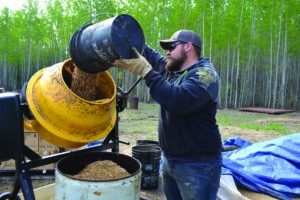
Mixing bait and freshening bait sites is a non-stop activity for bear guides and hunters. Be prepared to do some work if you're heading to bear camp. (Photo: Hilary Dyer)
Study Your Field Judging
Bears are one of the most difficult animals to field-judge accurately. Take note of a bear’s legs — if they look long, and you see a lot of daylight under his belly, it’s not a huge bear. Look at his ears — if they come out the top of his head (say, closer together than 11 o’clock and 1 o’clock on a clock face), and they look large compared to the size of his head, it’s not a huge bear. A trophy bear will have a big saggy belly and a large, square head with ears that look small and set off to the side.
You’ll likely be watching bait that’s in a 55-gallon barrel, which will give you a size reference. When he stands right next to the barrel, you want to see his shoulder come close to the top of the barrel. That’s a pretty good bear.
Try to identify a spot on a nearby tree that’s approximately as tall as the barrel, so if the first bear knocks the barrel over (a very likely scenario), you still have your height reference.
Mack and his guides hang a beaver carcass from a pole suspended between two trees. It’s just high enough for a big bear to stand up straight and swat at it. If you have a bait that hangs like this, or a “honey pot” hung at a specific height, it can be another useful size reference. Take note of how high off the ground the bait is hung and use it to evaluate how tall a bear is when he stands up.
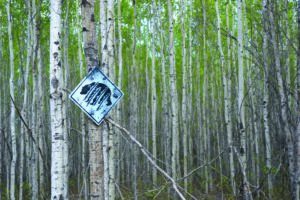
Bears are at home in the woods, which may be beautiful but aren't your stomping grounds. Watch and learn about bear behavior before heading out to hunt. (Photo: Hilary Dyer)
Watch the Bear’s Behavior
The way a bear behaves is an important key to field-judging. Hunting pressure and region affect behavior, of course, but you should pay attention to how a bear approaches a bait site. Is he cautious, walking like a deer, pausing every few steps to look around? Or does he strut in like he owns the place? If he seems like he’s not afraid of anything, it’s because he’s not. He’s the biggest bear in this area and he knows it, and you should probably shoot him.
A tentative bear who feeds cautiously and sneaks around like a kid stealing candy is afraid of the bigger bear that’s in the area. Watch and wait.
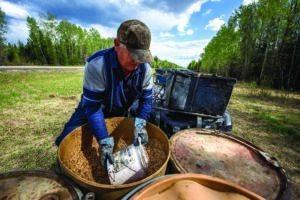
Baited sites attract boars and sows, some of which may have cubs. Be sure to look up in the trees around your stand before climbing and if you see anything consider getting out of there. A sow with cubs can be a dangerous situation. (Photo: Hilary Dyer)
Be Safe
Baiting bears puts you in close quarters with large, toothy predators. There are a couple of safety tips to keep in mind.
First, when you arrive at your tree, look up. If there’s a cub in your tree or any nearby trees, strongly consider getting out of Dodge. A sow with this year’s cubs (they’ll be the size of house cats or not much larger) is a dangerous animal. If she gets nervous about anything, she’ll shoo those cubs up a tree, and if they pick YOUR tree, they can climb above your head faster than you know what’s happening. Suddenly you’re in the most dangerous place in the world, and the likelihood of getting out peacefully is very low.
Second, black bears are naturally curious, and one might want to climb into your tree and try to figure out what you are. Every hunter has a different comfort level regarding how close they let a bear get before they start shuffling their feet, yelling at the bear to back down, kicking it in the snout, or whatever else is necessary. Decide where your personal line is before you need it!
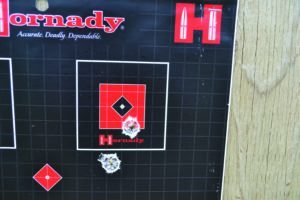
The 12-gauge slug is a solid round for bear hunting, especially with close shots from a stand in a clearing. (Photo: Hilary Dyer)
Pack the Right Heat
You don’t need a .375 H&H to kill a black bear on a bait site, and since your shots are almost certainly going to be close (50 yards and under), you don’t need lots of speed and sub-MOA groups at long range, either. You do need massive energy transfer and a projectile that penetrates well through thick hair and layers of fat in order to reach vital organs.
A slug gun is ideally suited for a baited bear hunt, and for my bear hunt, I chose a 12-gauge Mossberg 930 Slugster, which gave me abundant ammo options and all the power I could ask for at close range, all in a compact package. The Slugster has a rifled barrel for increased accuracy, and it features a cantilevered rail for adding a scope. The rail is attached directly to the receiver, which makes swapping barrels easy if your bear gun does double duty as a smoothbore scattergun for birds or close-range varmints.
I’m not very recoil sensitive, but I also don’t believe in taking a beating for no reason. The Slugster’s got a recoil pad and barrel vents at the muzzle that help tame the punch of heavy slugs, and, of course, the gas system of the semi-auto action reduces recoil just by a function of how it operates. I sighted it in at 50 yards, and it proved to be dead accurate.
I find that nothing in the world will take the sting out of recoil like adrenaline, and there’s no short supply of that in bear hunting, but it still helps to have effective ammo that won’t beat you up. For slugs, check out Hornady’s FTX Custom Lite line. They’re 2¾-inch shells with a 300-grain bullet, designed to further tame recoil and muzzle blast. They’re made to shoot in rifled slug gun barrels, which makes them more accurate by default. I killed two bears with this combo, both with broadside, right-behind-the-shoulder shots. One ran about 40 yards before piling up, and one dropped where it stood at the bait barrel.
Gear Up Properly for Bear
As for clothing, safety harnesses and the like, the gear you use for any other type of hunting is appropriate for bear hunting. Bears will almost certainly know you are there, so don’t spend too much time trying to hide your human scent. As on any spring hunt, if the weather is even slightly warm, pack a Thermacell. The last thing you want to be doing is spending all your time on stand swatting mosquitoes.
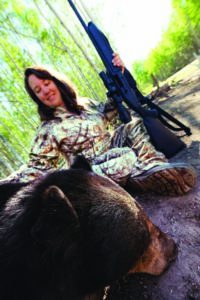
When everything works as planned, the result can be a trophy and memories that last a lifetime. (Photo: Tess Rousey)
One thing to consider are your optics. A rangefinder might or might not be helpful, depending on how open the area around your bait stand is. Good binos are a must for field-judging. A lightweight, clear bino like the Swarovski EL 8x32 will let you scrutinize things like ear size and positioning, to help you with field judging.
As in most hunting, the bear-hunting action often happens in low light conditions. You want a riflescope with a high percentage of light transmission and a wide field of view, but you don’t need much magnification at the relatively close ranges you’ll encounter on a baited bear hunt. I chose the Swarovski Z8i 1-8x24 L, which offers a field of view of 127.5 feet at 1X. That let me keep an eye on the area while waiting for a perfect shot opportunity.
The Z8i has two reticle options. The BRT-I reticle allows you to coordinate your chosen load’s ballistics with the hashmarks on the reticle, but I knew I wouldn’t need ballistic precision at bear-baiting ranges, so I went with the simpler 4A-IF reticle — an illuminated orange circle and center aiming point at the intersection of the crosshairs.
If you think illuminated reticles are a waste of time or “one more thing to worry about,” then you’ve never tried to settle a black crosshair on an all-black, furry blob of a target. Trust me — you want bright (but adjustable) illumination in a contrasting color.
Now, Forget All That Field-Judging Stuff
Well, not all of it. It’s all good and useful information, but the bottom line is that any legal bear you’re happy with is a good bear.
The average black bear shot in North America is around 5 1/2 feet nose to tail, depending on who you ask. But bears in different areas have different potential, and a “small bear” in one state might be considered a big bear in another region where bears are more scarce or just don’t get as large. Ask your outfitter or study up on the area you’re hunting to find out what’s considered a “good bear” in your region.
Too, don’t forget that the time of year plays a major role. Spring bears just coming out of hibernation have used up so much of their fat stores over the winter that they might look skinnier and leggier than you’d expect out of a mature bear. Just because a bear doesn’t have that saggy belly I told you to look for doesn’t mean he’s a small bear. He might have just had a long, hard winter. And like humans, big bears have different shapes. Some are just built tall and skinny; others are short and fat.
Of course, if you have your heart set on a color-phase bear, all the field-judging advice becomes relative. On the second night of my six-night hunt, I had watched a couple of 6-foot black bears hang around my bait for hours. That early in the hunt, I was determined to hold out for a 7-footer. But when a flash of cinnamon fur came trotting into view, my only thought was “It’s bigger than a yearling!” Bang! He was dead before he even got close to the bait barrel. That bear measured 6 foot 1 inch, and I couldn’t be happier.
Any legal bear you’re happy with is your bear, period.
More top picks from Predator Xtreme:
How to scout in summer for coyotes
3 tips to hunt coyotes the simplest way possible
Coyote 101: Understanding how songdogs rear pups
Wild hogs: A must-hunt species






